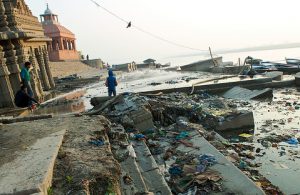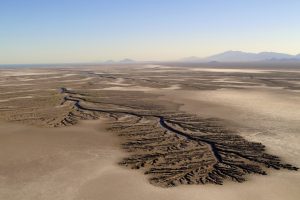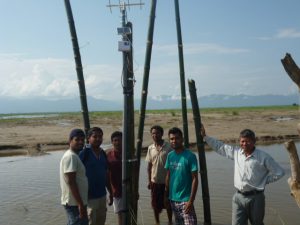A few years ago I made a journey to the source of the Ganga – now chronicled in the first chapter of my book Dirty, Sacred Rivers. When I walked up to Gaumukh, my book did not yet have a title; and was far from being a book. But a central question was already very much in my mind: why are the rivers of South Asia, which are so sacred in the minds of Hindus, now so filthy and so roundly abused?
I can’t say I found an entirely satisfying answer to the question. Instead like Ithaca, in Cavafy’s eponymous poem, the question gave me the journey. During that trip I saw and came to understand a few things about the vast region known as the greater Ganga river basin—a basin that encompasses most of the Indian and Nepal Himalaya, the Gangetic plain of north India, the Nepal terai and Bangladesh.
Eventually I did find several partial answers to the question. Subcontinental rivers have been abused during a rapid increase in population and industrialisation. Laws against release of industrial effluent are either inadequate or unenforced; major rivers are severely polluted. Nor has sewage management kept pace with population increase and urbanisation. Adopting flush toilets and launching inadequate versions of Western methods of sewage management have turned the rivers in many South Asian cities into sewers.
A few decades ago there was less garbage and more reuse in the poorer, less industrialised subcontinent. A lack of methods to manage solid waste had not yet become an issue. But instead of biodegradable clay cups for tea and leaves for plates, many South Asians now use plastic packaging. With more “stuff” available to buy and more money to buy it, there is more to throw away, often into rivers.
Further, in the overflowing cities, often full of migrants from rural regions, people have lost the intimate, virtually familial relationship they once had with their local streams and rivers. Urinating, defecating or throwing garbage into a water body no longer seems like despoiling one’s own home. And in a megacity like Delhi, even the people whose families had lived there for generations have lost their connection to the sacred but filthy Yamuna.
Add to all this a belief that the rivers are self-cleansing. The rivers’ flowing, oxygenated waters indeed always had been self-cleansing, simply because a smaller population polluted them far less than vast cities now do as they churn out sewage and industrial waste. But the rivers have been betrayed by this belief in their supernatural ability to cleanse themselves. As one man said, when I spoke to him near the edge of the blackened and benighted Yamuna river in Delhi: it is not the water that is dirty, but our minds and hearts. In other words, the river is magic even though to our eyes it looks and smells like a cesspool. Would that this were true. This collision of ancient belief and contemporary crud has not served the rivers well.
In addition to the cascade of pollution, manipulation of South Asia’s rivers to serve human needs for irrigation, household water and hydropower has not necessarily served the rivers well either, nor the people who depend on them. Dam building, largely suspended in the West, has been going on apace in India for the past half century. Amidst much protest, government and industry have proceeded to build both large structures like the Tehri Dam and many smaller, so-called run of the river dams, even high in the Himalaya.
The industrialisation of rivers began when India was under British colonial rule; some rivers became money-making entities for shipping or irrigation water. Over time many locally appropriate methods of managing water supply - even for managing floods – that had been traditionally practised throughout the subcontinent were replaced by centralised approaches. Post independence Indian governments continued this trend; local control and local management of water and rivers was gradually abandoned. Methods of local groundwater replenishment, for example, ceded to large irrigation schemes, canals, and later to water piped long distances. To feed a growing population, the government subsidised electricity (some of it generated from dammed rivers), which allowed farmers to pump too much groundwater and deplete the water table.
People were separated from their water, their shared ownership of it, their involvement in its appropriate management and use. A direct outgrowth of this trend is a proposal like India’s Interlinking of Rivers, which would require moving water from “water rich” to “water poor” regions by means of a maze of canals and dams. There is much opposition to these ideas, along with the beginnings of a movement back to local water management. In time, these trends might lead to a more balanced approach to water resources, to people regaining some sense of ownership of and responsibility for their local water bodies.
But can this trend move fast enough? Tremendous change is underway, especially in India. The loss of rivers as sacred is perhaps just part a profound transformation of the culture.
Nonetheless a sense of the sacred persists throughout South Asia. I saw it in Nepal during my five years residence. And in India many of the thousands of people killed, stranded, or terrified up in Uttarakhand were on pilgrimage when debris flows inundated Kedarnath, one of the destinations on the ancient Char Dham Yatra. In June 2013 intense rains fell in what seemed an unusually early and heavy monsoon rain.
Still, those rains were not necessarily outside the range of past monsoons. We may not know for a while exactly how the devastation of Kedarnath came about, though part of it appears to be due to a lake that burst its moraine. The Himalaya and its denizens will face similar threats for a long time to come, because of global warming on the one hand, and on the other because of development (dams, roads, buildings in the wrong places, or built to inadequate codes). And there will be floods and landslides simply because of the unpredictability of the Himalaya.
There may be no retrieving the idea of the sacred as it applies to South Asia’s rivers, so perhaps the only solution is a version of the Clean Water Act: laws, fines, enforcement, a corporate culture of responsibility, an increasingly prosperous public educated and habituated to rubbish bins and toilets. In such a framework, rivers are indeed economic resources, and thus must be treated better than they are now for the sake of the greater economy: the health and wealth of the population. They must be given serious protection, not lip service about how sacred they are.
All this could accomplish what the Vedas holy texts once enjoined. The result would be similar, in this vastly different industrialised and digitised world we live in. It seems the spirit would be lost, yet on the other hand the Vedas and other religiously based injunctions for protecting water were meant for the common good, clothed in the language of the time, a priestly version of parliament. In post-industrial South Asia this may be the only answer. It may even be a good one.





